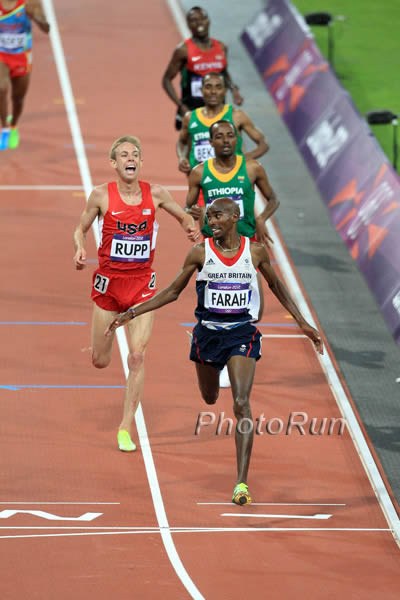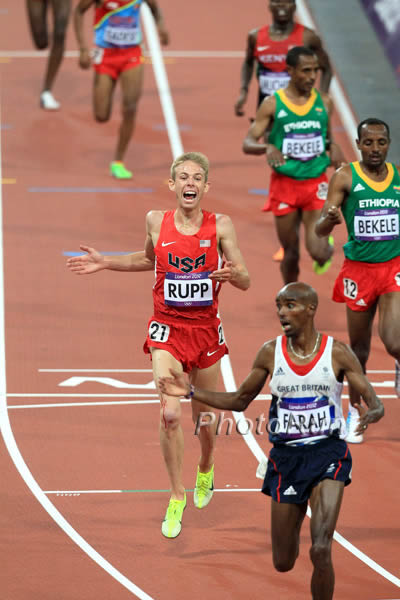
Mo Farah, Galen Rupp, London 10,000 meters, photo by PhotoRun.net
Mo Farah, Galen Rupp, Tariku Bekele, London Oympic 10,000 meters,
photo by PhotoRun.net
The 10,000 meters, the longest race on the track is 25 laps. In those 25 laps, one has many times to make an error. A championship 10,000 meters is even more fraught with complication. Last year, at the World Champs 10,000m, Mo Farah out ran all but one in the race. Mo Farah obviously learnt from that race.
The 1,2 finish of Mo Farah and Galen Rupp was not just two great training partners, two mates training well and racing well, it was the cooperation of coaches, supporters in two countries. Athletes from Great Britain’s rich tradition, Dave Bedford, Ian Stewart and Sebastian Coe were involved. Uk Athletics Neils de Vos and Charles van Commenee gave support. And Alberto Salazar brought the two young men, under his wing. Last February, Alberto and Ian told me how please they were that both guys were training together so well.
It is one of the greatest successes of Uk Athletics in this Olympics and one of the greatest successes of Team USA as well, as Mo Farah won the first 10,000m gold for the British team and Galen Rupp took the first silver medal for US in the 10,000m since 1964 (oh, before that, was 1912).
This championship race was not going to be a fast one. Kenenisa Bekele, the WR at the 10,000m and 5,000m, led the first kilometer in 2:54.88, with all in tow. Wilson Kiprop of Kenya, the Olympic Trials champ for Kenya, lead the second kilometer, in 5:59.56,
running an even slower 3:05. Kiprop would drop out of the race later.
Zersenay Tadese, from Eritrea, took over the pace, and hit the 3,000m in 8:42.45, a proper kilometer split as the field started to string out. Both Bekeles, Tariku and Kenenisa were there, as was Galen Rupp, Dathan Ritzehein, Matt Tegenkamp, and of course, Mo Farah. The top Kenyans were there as well as all three Ethiopians.
Tadesse took the field through 11:23.16 for 4000 meters (2:41), and hit the 5,000 meters in 14:05.79 (2:42). A solid pace, but not killer. Yet.
The pack was down to twelve as Tadesse pushed along, the 6,000 meters hit in 16:52.7, which slowed the pace down, giving the field time to breathe again. During this jaunt, Galen Rupp looked relaxed and Mo Farah moved around a bit, checking out the field, dodging and weaving, like a boxer.
That Mo Farah has eyes in the back of his head is a given. This guy has spidey senses. A strong tactician before, Mo Farah is the complete distance runner, which is what Alberto Salazar is all about-completeing the education of elite distance runners. Galen Rupp would say afterwards how Alberto and Galen had talked about the Olympics since he was a sophomore in high school. Those talks obviously were paying off.
The pace might now be quickening, but the pressure was. Moses Masai took the lead though the seventh kilometer, the fastest of the race, at 2:40, hit in 19:32.58. It just past here that
Wilson Kiprop, the Kenyan Olympic Trials champ, dropped out.
What I could not figure out afterwards was why the Kenyans, and Ethiopians for that matter, gave the race to Mo? They actually thought they could outkick the Brit, who had shown, for the past 18 months, that his last 700 meters, and especially, his last 400 meters were deadly? Galen Rupps’ 52.4 last 400 meters in the US Trials at 5,000 meters should have given them pause.
Moses Masai continued to lead through the 8,000 meter mark, in 22:15, which was a 2:43, and did not drop anymore in the top eight. Mo Farah was there, Galen Rupp was there, Tariku and Kenenisa Bekele, Tadesse, Masai and Gebre Gebrariam, former ING NYCM marathon champion, and the man who dropped the pace between 8 kilometers and 9 kilometers.
The pace dropped down to 2:36 for the ninth kilometers, hit in 25:01.97. Gebre Gebremariam found Mo Farah next to him, Tariku and Kenenisa Bekele, Galen Rupp and Tadesse in tow. The crowd was screaming, willing Mo Farah on, as the pace became faster and faster.
The final kilometer of the race was run in 2:29, with the final 800 meters under 1:53 as Mo Farah, who moved to the front at 700 meters, began to relentlessly increase the pace, as Farah strung out the field. Gebre Gebremariam started to fall back as Kenya’s last hope, Bedan Muchiri, Tariku Bekele and Kenenisa Bekele challeged Farah.
Mo Farah was reletentless, he would not give an inch. Farah would run the last lap in just over 53 seconds, but his penultimate lap had taken the sting out of his competitors kicks.
And yet, the race was not over! As Mo Farah focused on the two Bekeles, and Muchari, Galen Rupp his training partner, moved into lane two and flew down the last stretch. Never far back, Rupp passed Muchari, then Kenenisa Bekele, and then, finally, with thirty meters to go,
Tariku Bekele.
As Mo Farah, with a face that showed surprise, pleasure and release that the pressure of running for the gold was over, looked back, sensing Galen close and saw his team mate take the silver, the photo was priceless.
Mo Farah had won the first 10,000 meters for Great Britain, and Galen Rupp had taken the first medal by an American male in the 10,000 meters since 1964!
A few nights later, when meeting with Ian Stewart, the bronze medalist at 5,000 meters in Munich, Ian reminded me that he had told us how well Mo Farah would do, last February. Smiling, Stewart looked at me, and said, ” Why don’t you believe?”.
I am a believer now.
————————————————————————————-
The XXX Olympic Games
London (GBR) – Saturday, Aug 04, 2012
10,000 Metres – M
FINAL————————————————————————————-
| Position | Bib | Athlete | Country | Mark | . |
|---|
| 1 | 1808 | Mohamed Farah | GBR | 27:30.42 | . |
| 2 | 3250 | Galen Rupp | USA | 27:30.90 | . |
| 3 | 1680 | Tariku Bekele | ETH | 27:31.43 | . |
| 4 | 1679 | Kenenisa Bekele | ETH | 27:32.44 | . |
| 5 | 2313 | Bedan Karoki Muchiri | KEN | 27:32.94 | . |
| 6 | 1599 | Zersenay Tadese | ERI | 27:33.51 | . |
| 7 | 1597 | Teklemariam Medhin | ERI | 27:34.76 | . |
| 8 | 1686 | Gebregziabher Gebremariam | ETH | 27:36.34 | . |
| 9 | 3073 | Polat Kemboi Arikan | TUR | 27:38.81 | (PB) |
| 10 | 3114 | Moses Ndiema Kipsiro | UGA | 27:39.22 | . |
| 11 | 1293 | Cameron Levins | CAN | 27:40.68 | . |
| 12 | 2311 | Moses Ndiema Masai | KEN | 27:41.34 | . |
| 13 | 3247 | Dathan Ritzenhein | USA | 27:45.89 | . |
| 14 | 2904 | Robert Kajuga | RWA | 27:56.67 | (PB) |
| 15 | 1600 | Nguse Tesfaldet | ERI | 27:56.78 | . |
| 16 | 3110 | Thomas Ayeko | UGA | 27:58.96 | . |
| 17 | 2371 | Moukheld Al-Outaibi | KSA | 28:07.25 | . |
| 18 | 1279 | Mohammed Ahmed | CAN | 28:13.91 | . |
| 19 | 3257 | Matthew Tegenkamp | USA | 28:18.26 | . |
| 20 | 1061 | Ben St.Lawrence | AUS | 28:32.67 | . |
| 21 | 2497 | Diego Estrada | MEX | 28:36.19 | . |
| 22 | 2234 | Yuki Sato | JPN | 28:44.06 | . |
| 23 | 1621 | Ayad Lamdassem | ESP | 28:49.85 | . |
| 24 | 2138 | Daniele Meucci | ITA | 28:57.46 | . |
| 25 | 1837 | Christopher Thompson | GBR | 29:06.14 | . |
| 26 | 3136 | Mykola Labovskyy | UKR | 29:32.12 | . |
| . | 1253 | Ali Hasan Mahbood | BRN | DNF | . |
| . | 1575 | Bayron Piedra | ECU | DNF | . |
| . | 2301 | Wilson Kiprop | KEN | DNF | . |
Larry Eder has had a 52-year involvement in the sport of athletics. Larry has experienced the sport as an athlete, coach, magazine publisher, and now, journalist and blogger. His first article, on Don Bowden, America's first sub-4 minute miler, was published in RW in 1983. Larry has published several magazines on athletics, from American Athletics to the U.S. version of Spikes magazine. He currently manages the content and marketing development of the RunningNetwork, The Shoe Addicts, and RunBlogRun. Of RunBlogRun, his daily pilgrimage with the sport, Larry says: "I have to admit, I love traveling to far away meets, writing about the sport I love, and the athletes I respect, for my readers at runblogrun.com, the most of anything I have ever done, except, maybe running itself." Also does some updates for BBC Sports at key events, which he truly enjoys. Theme song: Greg Allman, " I'm no Angel."
View all posts























